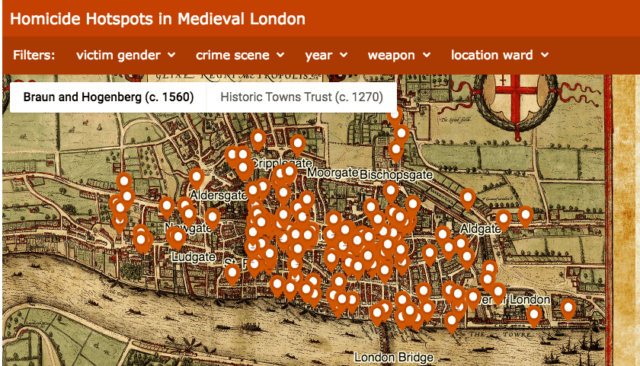

Lose yourself in this highly addictive “murder map” of medieval London
source link: https://arstechnica.com/science/2019/01/addictive-interactive-murder-map-lets-you-explore-medieval-london-crime/
Go to the source link to view the article. You can view the picture content, updated content and better typesetting reading experience. If the link is broken, please click the button below to view the snapshot at that time.

On the 11th day of Christmas —
Lose yourself in this highly addictive “murder map” of medieval London
14th century Clue: It was the priest with the long knife in the garden.
Jennifer Ouellette - 1/5/2019, 4:08 AM

In July of 1316, a priest with a hankering for fresh apples sneaked into a walled garden in the Cripplegate area of London to help himself to the fruits therein. The gardener caught him in the act, and the priest brutally stabbed him to death with a knife—hardly godly behavior, but this was the Middle Ages. A religious occupation was no guarantee of moral standing.
That's just one of the true-crime gems to be found in a new interactive digital "murder map" of London compiled by University of Cambridge criminologist Manuel Eisner. Drawing on data catalogued in the city Coroners' Rolls, the map shows the approximate location of 142 homicide cases in late medieval London. The map launched to the public in late November on the website for the university's Violence Research Center, and be forewarned—it's extremely addictive. You could easily lose yourself down the rabbit hole of medieval murder for hours, filtering the killings by year, choice of weapon, and location. (It works best with Google Chrome.)
"The events described in the Coroners' Rolls show weapons were never very far away, male honor had to be protected, and conflicts easily got out of hand," said Eisner, who embarked on the project to create an accessible resource for the public to explore the historical records. "They give us a detailed picture of how homicide was embedded in the rhythms of urban medieval life."

Eisner geocoded all the cases after determining approximate locations for the crime scenes. Often, the records were vague on that score, but the murder of Christina de Mestre in 1300 was very specific: she was killed in the "churchyard of St. Mary de Wolcerchehawe in the Ward of Walebrok." The murders usually occurred in public streets or squares, and Eisner identified a couple of "hot spots" with higher concentrations than other parts of London. One was a particular stretch of Cheapside running from St Mary-le-Bow church to St. Paul's Cathedral. The other was a triangular area spanning Gracechurch, Lombard, and Cornhill, radiating out from Leadenhall market.
Advertisement"Over 18 percent of victims survived at least a week after the initial trauma."
The perpetrators were mostly men (in only four cases were women the only suspect). As for weapons, knives and swords of varying types were the ones most frequently used, accounting for 68 percent of all the murders. The greatest risk of violent death in London was on weekends (especially Sundays), between early evening and the first few hours after curfew. Roam the streets during those hours, and you'd be far more likely to end up like John of Canterbury, a saddler who was beaten by a couple of boatmen with wooden oars, "inflicting a wound that penetrated the brain." Poor John died the following day.
As Eisner notes, "Sunday was the day when people had the time to engage in social activities—drinking and playing games that would occasionally trigger frictions leading to assault." Mondays were the second most likely day for homicides, perhaps because frictions spilled over from the weekend. And, Eisner says, sometimes victims of violent assault didn't die right away (like John the Saddler), lingering for hours, days, and sometimes weeks before succumbing to their injuries. "Over 18 percent of victims survived at least a week after the initial trauma, probably dying eventually from infections or blood loss," said Eisner.
The population of London in the 14th century likely ranged between 40,000 and 100,000 people. In a city of 80,000, the medieval London murder rate would be 15 to 20 times higher than an English town of comparable size today, according to Eisner. But he is leery of drawing direct comparisons to modern society. "We have firearms, but we also have emergency services," he said. "It's easier to kill, but easier to save lives."
Recommend
About Joyk
Aggregate valuable and interesting links.
Joyk means Joy of geeK